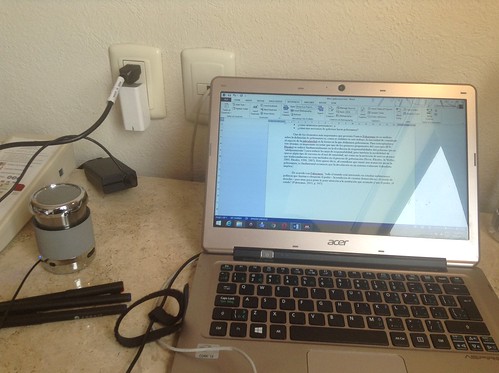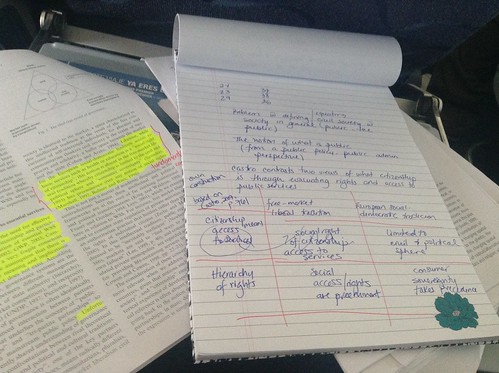My good friend (and graduate school colleague) Amanda Bittner (who is a professor of political science at Memorial University of Newfoundland) was asking on Facebook how do other fellow academics keep up with journal article reading (and reading, in general) other than binge-reading for when we are preparing a syllabus or writing a paper. I am not going to claim by any stretch of the imagination that my process is efficient, nor that I’m good at keeping up with journals and/or reading articles or book chapters or even books. But I promised Amanda I would blog about what I do and how do I do it, so the second in my series of My AcWri Strategies posts (the first being my suggestion that you should be working at the paragraph level instead of frustrating yourself with filling up pages) is how I integrate reading into my writing workflow (and perhaps you could take up some of the recommendations I have here for your own process).
Here is a brief summary of what I do to keep up with journals and maintain a steady stream of articles in my reading pile. I track both gray literature and academic literature, so I will interweave both into my comments on this post.
1. I have set up Google Alerts for specific research topics (sanitation, privatization, remunicipalization, Mexico, water policy). This helps me keep my finger on where the global conversation is. A little bit of a problem is that I track both terms in English and in Spanish, so this becomes a little bit too much information to filter. But I usually go through my alerts when I’m writing specific papers, or updating my memorandums (I’ll explain what a memorandum is below).
2. I have set up email alerts for the tables of contents of journals. Many (a bit too many, in my view) journals. This helps me see what’s being published. I only have journal table of content alerts in English, as I really don’t track the Spanish language ones. You could say I’m excluding myself from a lot of the conversation that is happening around water policy in Mexico in Spanish. However, I’m subscribed to the Network of Social Scientists of Water in Mexico (RISSA, in Spanish), and most people promote their own journal articles so I feel I’m connected to the Spanish language literature.
3. I print out interesting papers that I may want to read later. Call me old fashioned, but I am used to reading in print, highlighting with actual highlighter pen, writing notes by hand both on the margins of the article and then typing those notes in a memorandum. I sort these journal articles, book chapters, reports, etc. per topic, and I add a little sticker with the article/book chapter’s authors’ last names and year of publication for easy access. Then, whenever I am travelling, I choose a few of those to bring with me. This is often problematic when I feel like I have too much to read, where I switch to an electronic version instead and bring my tablet.
4. I write memoranda to summarize and imprint what I learned from an article into my memory. I learned to write memoranda from Brian O’Neill, a professor of social work who teaches qualitative methods. He taught me to always write “memos to myself” (e.g. self-reflective notes). Drawing on insights from his class, I decided to write summaries of journal articles, book chapters, etc. Each memorandum has a title (that is usually descriptive enough and that I replicate in the MS Word file) and then I summarize the journal article. I draw quotes from each article/book chapter and type them out. This method of using memoranda helps me because whenever I want, I can cite/quote an author, and I already have the text typed (copy-and-paste in this case is your best friend).
5. I read when I travel. Because I travel so much (for conferences, workshops, fieldwork and to visit my parents), I use those travelling times to read. But along the same lines, I always make notes (handwritten if there is no space to use my laptop computer) and highlight relevant text.
6. I read every morning to kick-start my writing. This is a strategy that I didn’t invent. My former professor, Terre Satterfield, suggested to me that she always read an article or book chapter to get her thinking going. I figured that if I was going to read, I should always write summaries of those articles/book chapters/reports. I also link specific reading I do with the paper/manuscript I’m working on.
7. Sometimes, I binge-read. I am not above binge-writing or binge-reading (this is usually the case when I have a deadline and even my rigorous, 2-hours-a-day writing regime is not helping). What I do is a Google Scholar search, and also track the references that both cite articles I deem relevant, and those that are cited by specific authors. Sometimes, you got to do what you got to do. And I’m not about to scold anyone for binge-reading.
So these are my suggestions on how to integrate reading into my writing workflow. Again, full disclosure: I speed-read, and I have a pretty decent quasi-eidetic memory. Also, I have a very low teaching load (2-0), So I do read a lot because I can. But I really hope that sharing my strategies will possibly help others even if they’re more time-constrained, at least a bit.





One Response
Stay in touch with the conversation, subscribe to the RSS feed for comments on this post.
Continuing the Discussion